Our review of the Armin Strom Mirrored Force Resonance with guilloché dial. Hands-on article: Armin Strom Mirrored Force Resonance.
Lovers of fine watchmaking can’t help but get excited when they handle a watch like the Armin Strom Mirrored Force Resonance.
This eye-catching timepiece, features a patented resonating dual regulator system developed with the primary goal to increase precision and rate stability.
It utilizes two independent mainsprings, gear trains, escapements, and balances, each connected by a rack and pinion to allow fine tuning of the distance between them, and takes advantage of the resonance phenomenon, in which two oscillating bodies in close proximity influence each other and eventually synchronize at a preferential frequency.
Since its introduction at the end of 2016, this model stands firmly among our favorite timepieces seen in the last five years or so.
We like the daring approach to watchmaking that the brand demonstrated in taking the challenge to develop such a complex resonance-based regulating system and we love the aesthetic result, with all the key elements of the mechanism visible on the dial side for the joy of the wearer.
We had the opportunity to spend one week with the Mirrored Force Resonance in stainless steel and we are now sharing with our readers impressions and pictures.
The case has classic proportions with a diameter of 43.40 mm and a total thickness of 13 mm. Despite its pretty large size, the watch sits comfortably on the wrist thanks to the ergonomically designed short lugs. The clean lines of the case are highlighted by its meticulous finish alternating polished and satin-brushed surfaces. Water resistance is guaranteed up to a pressure of 5 ATM (approx 50 metres / 165 feet).
The lip positioned at 6 o’clock on the bezel is a hallmark of the brand. Armin Strom developed this additional surface on the case as a way to personalize the watch with engraved initials. Even if you prefer not to use it for the original scope, this element makes the Armin Strom watches even more recognizable.
The polished bezel frames the perfectly executed dial dominated by the resonance mechanism with the offset sub-dial on the right to display hours and minutes.
For our test, we chose a model with a grey guilloché decorated dial — we find the resulting monochromatic look very elegant — but it is important to remark that this is just one of the many possible combinations that the customer can create thanks to the Armin Strom Configurator. Dials are available with guilloché decorations (including blue, black, anthracite, red or bi-colour with various pattern options like sun-ray, concentric waves or barleycorn) but also with a matte finish in different colours. Even the hands can be chosen among five variations. This is a great plus because it allows the owner to fine-tune the timepiece to match his/her tastes.
The beautiful guilloché dial of our review timepiece was simply flawless, fully meeting the high expectations we had considering that Armin Strom teamed up with renowned Master Watchmaker Kari Voutilainen for the creation of these refined dials. They are manufactured in his Môtiers-based workshop, on century-old engine-turning lathes, which can only be controlled by hand.
The complete dial is indeed perfectly executed and the two connected oscillators making their revolutions in opposite directions - one rotating clockwise and the other counterclockwise - create a mesmerizing effect.
Nonetheless, Armin Strom’s primary goal when developing this patented resonating dual regulator mechanism was not to impress viewers but to increase precision and rate stability.
Getting more technical, one of the most important element of this complex mechanical system is the resonance clutch spring. Its shape is so sophisticated that Armin Strom had to create it in-house. It took two and a half years perfecting this spring, until it had the optimal form to connect Armin Strom’s two sets of oscillators.
When the two balances find a concurrent rhythm in opposite directions, there are at least three main advantages: a stabilizing effect on timekeeping, a conservation of energy (think of a cyclist riding in the shadow of another cyclist in a racing situation), and a reduction of negative effects on timekeeping accuracy due to outside perturbation.
For example, an outside shock that slows one of the balances down increases the speed of the other one by the same amount; both balances will strive to get back in resonance, thereby averaging and minimizing the effects of the outside influence as they find their rhythm.
If the 48-hour power reserve has been exhausted and the movement requires to be wound again, the twin balance wheels will need approximately 10 minutes to become synchronous. In case of any outside influence in the form of shock, it takes only a few minutes for the two balances to find their resonant rhythm once again.
This behaviour is explained by the fact that the resonance clutch spring connects the balance spring studs which receive the impulses rather than the balance wheels.
While improving the watch’s overall precision, the beauty of the resonance implementation used by Armin Strom also stands in the possibility to observe this phenomenon, and admire how the two resonant regulators work in a sympathetic manner, while wearing the watch on the wrist.
If you are asking yourself what is the function of the push-button at 2 o’clock, it serves to reset the twin seconds’ displays to zero, simultaneously resetting the twin balance wheels.
As we wrote, the key mechanical elements of the movement are visible on the dial, but the back side of the watch still has a lot to offer with the display of the double barrel which guarantees the 48-hour power reserve and that can be observed while they simultaneously wind.
Beating at a frequency of 3.5 Hz (25,200 vph), the hand-wound Calibre ARF15 is entirely conceived, manufactured, assembled, and regulated in-house. Plate and bridges are decorated at the highest quality level with hand-bevels, straight graining and Geneva circular graining.
The watch is matched to a genuine grey alligator horn-back strap with a double-folding stainless steel clasp whose perfect execution is a demonstration of the attention that the brand pays to even the smallest details. Despite being pretty thick, the strap is extremely comfortable and perfectly harmonized with the case. The watch comes with an additional black rubber strap.
The Armin Strom Mirrored Force Resonance model that we tested, with guilloché dial and deployant clasp, has a price of Swiss Francs 55,181 plus local taxes which is an attractive price for a watch of this complexity and exclusivity. Mechanical watch enthusiasts should be grateful to independent watchmakers like Armin Strom that are ready to take technical challenges like this. arminstrom.com
For an in-depth article on the resonance physical phenomenon applied to watchmaking, we invite to read our feature “In pursuit of precision: mechanical resonance and watches”.
It utilizes two independent mainsprings, gear trains, escapements, and balances, each connected by a rack and pinion to allow fine tuning of the distance between them, and takes advantage of the resonance phenomenon, in which two oscillating bodies in close proximity influence each other and eventually synchronize at a preferential frequency.
Since its introduction at the end of 2016, this model stands firmly among our favorite timepieces seen in the last five years or so.
We had the opportunity to spend one week with the Mirrored Force Resonance in stainless steel and we are now sharing with our readers impressions and pictures.
The case has classic proportions with a diameter of 43.40 mm and a total thickness of 13 mm. Despite its pretty large size, the watch sits comfortably on the wrist thanks to the ergonomically designed short lugs. The clean lines of the case are highlighted by its meticulous finish alternating polished and satin-brushed surfaces. Water resistance is guaranteed up to a pressure of 5 ATM (approx 50 metres / 165 feet).
The polished bezel frames the perfectly executed dial dominated by the resonance mechanism with the offset sub-dial on the right to display hours and minutes.
The beautiful guilloché dial of our review timepiece was simply flawless, fully meeting the high expectations we had considering that Armin Strom teamed up with renowned Master Watchmaker Kari Voutilainen for the creation of these refined dials. They are manufactured in his Môtiers-based workshop, on century-old engine-turning lathes, which can only be controlled by hand.
Nonetheless, Armin Strom’s primary goal when developing this patented resonating dual regulator mechanism was not to impress viewers but to increase precision and rate stability.
Getting more technical, one of the most important element of this complex mechanical system is the resonance clutch spring. Its shape is so sophisticated that Armin Strom had to create it in-house. It took two and a half years perfecting this spring, until it had the optimal form to connect Armin Strom’s two sets of oscillators.
When the two balances find a concurrent rhythm in opposite directions, there are at least three main advantages: a stabilizing effect on timekeeping, a conservation of energy (think of a cyclist riding in the shadow of another cyclist in a racing situation), and a reduction of negative effects on timekeeping accuracy due to outside perturbation.
For example, an outside shock that slows one of the balances down increases the speed of the other one by the same amount; both balances will strive to get back in resonance, thereby averaging and minimizing the effects of the outside influence as they find their rhythm.
If the 48-hour power reserve has been exhausted and the movement requires to be wound again, the twin balance wheels will need approximately 10 minutes to become synchronous. In case of any outside influence in the form of shock, it takes only a few minutes for the two balances to find their resonant rhythm once again.
This behaviour is explained by the fact that the resonance clutch spring connects the balance spring studs which receive the impulses rather than the balance wheels.
While improving the watch’s overall precision, the beauty of the resonance implementation used by Armin Strom also stands in the possibility to observe this phenomenon, and admire how the two resonant regulators work in a sympathetic manner, while wearing the watch on the wrist.
If you are asking yourself what is the function of the push-button at 2 o’clock, it serves to reset the twin seconds’ displays to zero, simultaneously resetting the twin balance wheels.
As we wrote, the key mechanical elements of the movement are visible on the dial, but the back side of the watch still has a lot to offer with the display of the double barrel which guarantees the 48-hour power reserve and that can be observed while they simultaneously wind.
Beating at a frequency of 3.5 Hz (25,200 vph), the hand-wound Calibre ARF15 is entirely conceived, manufactured, assembled, and regulated in-house. Plate and bridges are decorated at the highest quality level with hand-bevels, straight graining and Geneva circular graining.
The watch is matched to a genuine grey alligator horn-back strap with a double-folding stainless steel clasp whose perfect execution is a demonstration of the attention that the brand pays to even the smallest details. Despite being pretty thick, the strap is extremely comfortable and perfectly harmonized with the case. The watch comes with an additional black rubber strap.
For an in-depth article on the resonance physical phenomenon applied to watchmaking, we invite to read our feature “In pursuit of precision: mechanical resonance and watches”.



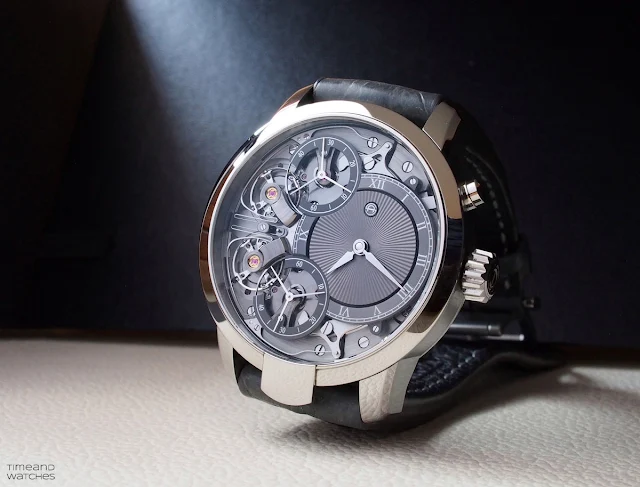

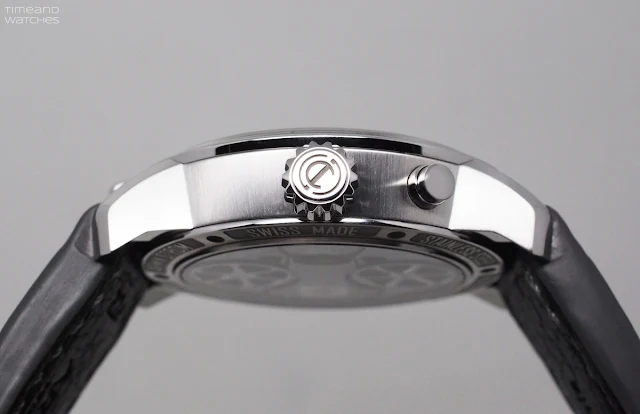

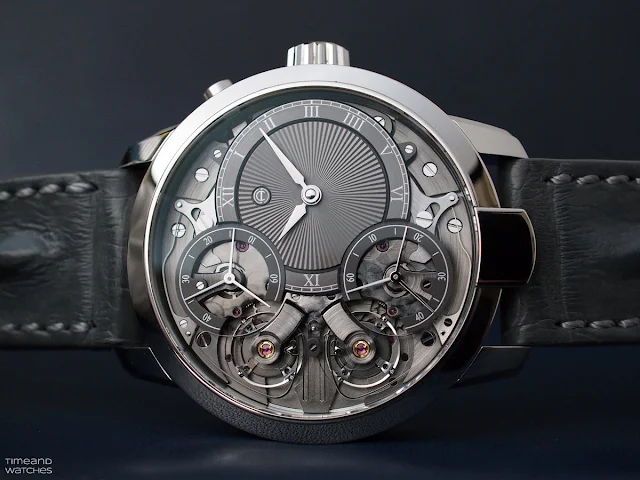


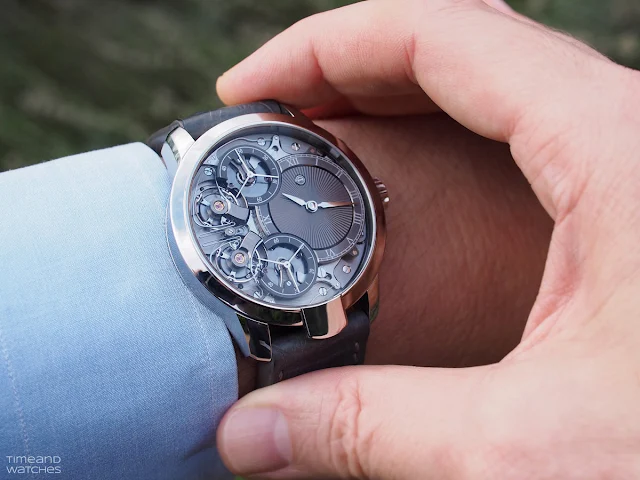
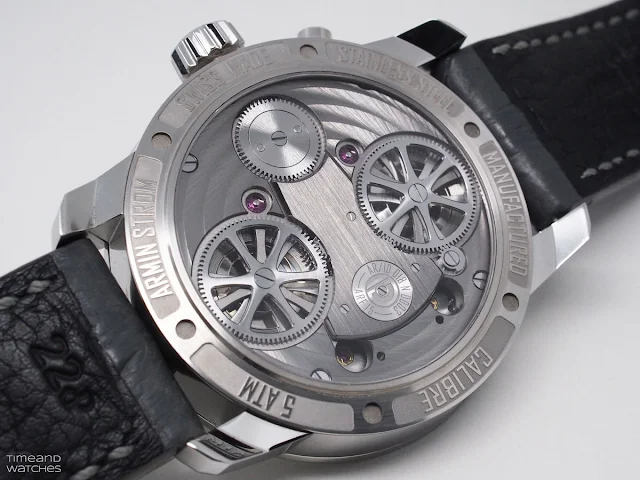
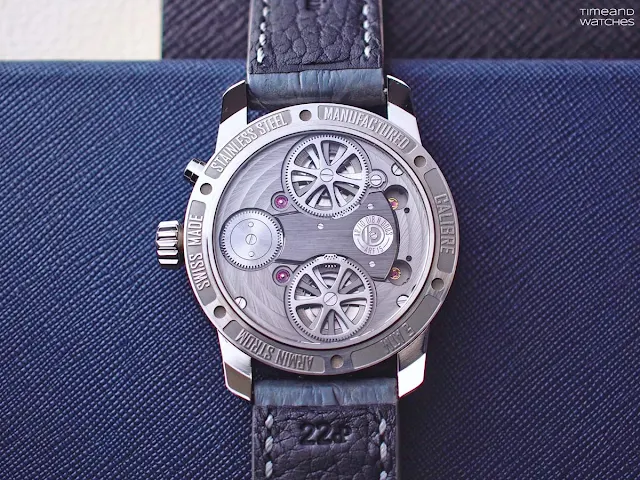


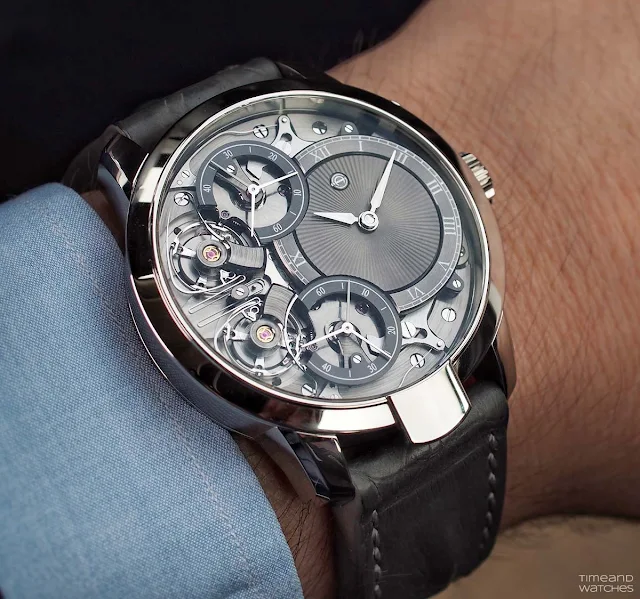









This is a maginificent watch. Love how it sits on the wrist in the pocket shot!
ReplyDeleteI was considering that the street price of a Nautilus 5711 in steel has become 50k€. With the same amount of money you can buy an incredible watch like this with an exceptional patented mechanism, guilloche dial and top finishes!
ReplyDelete